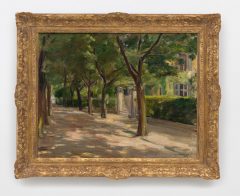Liebermann Villa Berlin:
"AUF NACH ITALIEN! Mit Liebermann in Venedig, Florenz und Rom"
May 4 - September 2, 2024
With the publication of Goethe’s Italian Journey (1786-88), Italy was established as a vital destination for artists from across German-speaking Europe. Max Liebermann (1847-1935) also explored the country, although his relationship with Italy was initially distant and sometimes ambivalent. He much preferred Holland, as he wrote to his fellow artist, the Dutch painter Jozef Israëls: “Perhaps Italy is more picturesque […] than Holland; but […] Italy is too picturesque.” (Max Liebermann: Gesammelte Schriften, Berlin 1922, p. 99).
Yet despite such assertions, Liebermann travelled to Northern Italy, Tuscany and Lazio at least six times between 1878 and 1913. While there, he came into contact with representatives of the Italian art scene, regularly participated in exhibitions and found inspiration for his own works. In 1908 he was commissioned by the director of the Uffizi Gallery to paint a self-portrait for the museum’s collection – the work remains to this day in Florence. His participation in the first International Art Exhibition in Venice in 1895 marked the beginning of his regular participation in Italian art exhibitions.
This exhibition explores Liebermann’s relationship with Italy for the first time. It is organized in cooperation with the Museum Casa die Goethe in Rome and stands under the patronage of the Embassy of the Federal Republic of Germany to the Italian Republic, and the Italian Embassy in the Federal Republic of Germany. The museum is grateful for the collaboration with the Museo Nazionale Romano, which honours a further connection between Liebermann and Rome: his mural in the loggia of the Villa am Wannsee was inspired by the ancient garden painting in the Villa di Livia near Prima Porta, which is now kept in the Roman National Museum.
The museum is grateful for the collaboration with the Museo Nazionale Romano, which honours a further connection between Liebermann and Rome: his mural in the loggia of the Villa am Wannsee was inspired by the ancient garden painting in the Villa di Livia near Prima Porta, which is now kept in the Roman National Museum.
